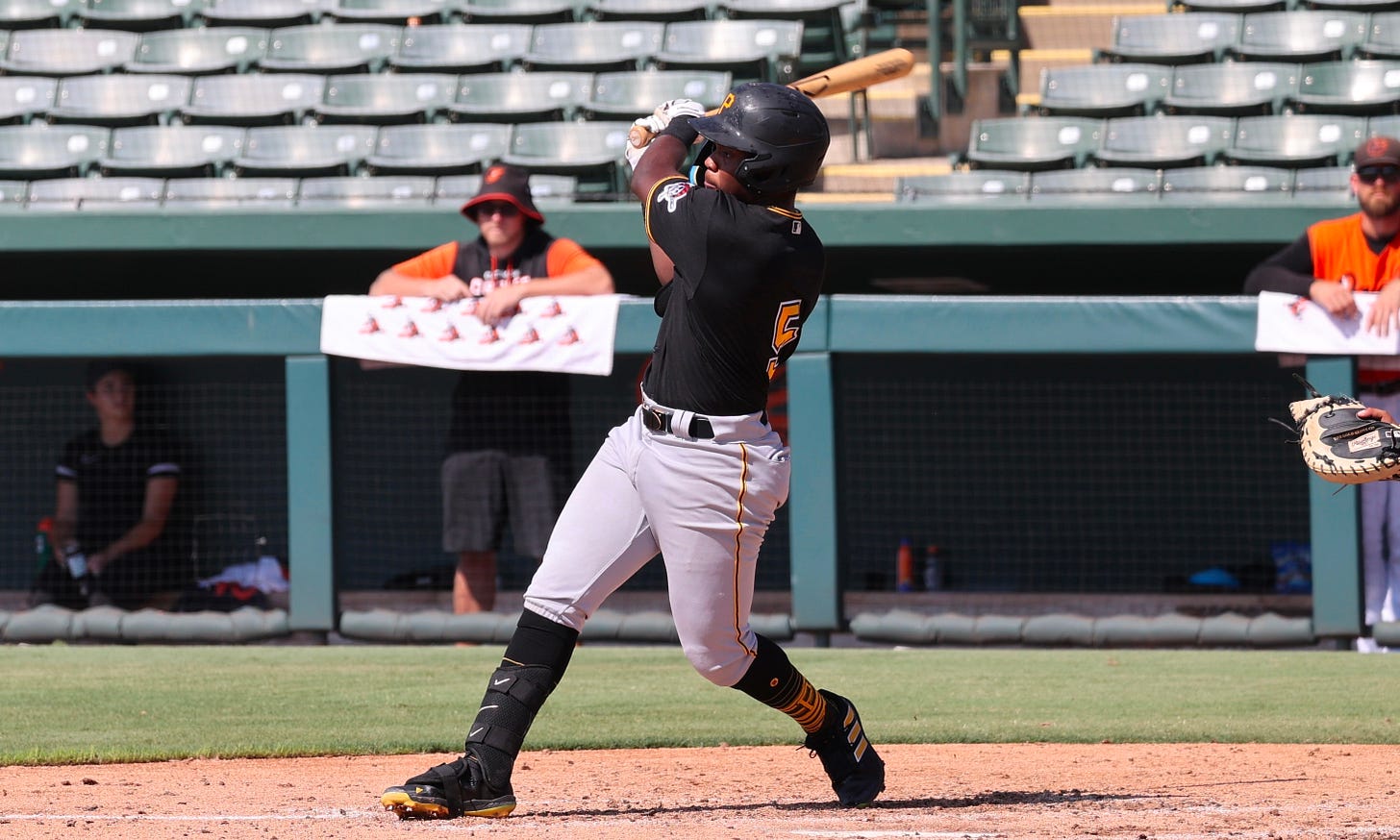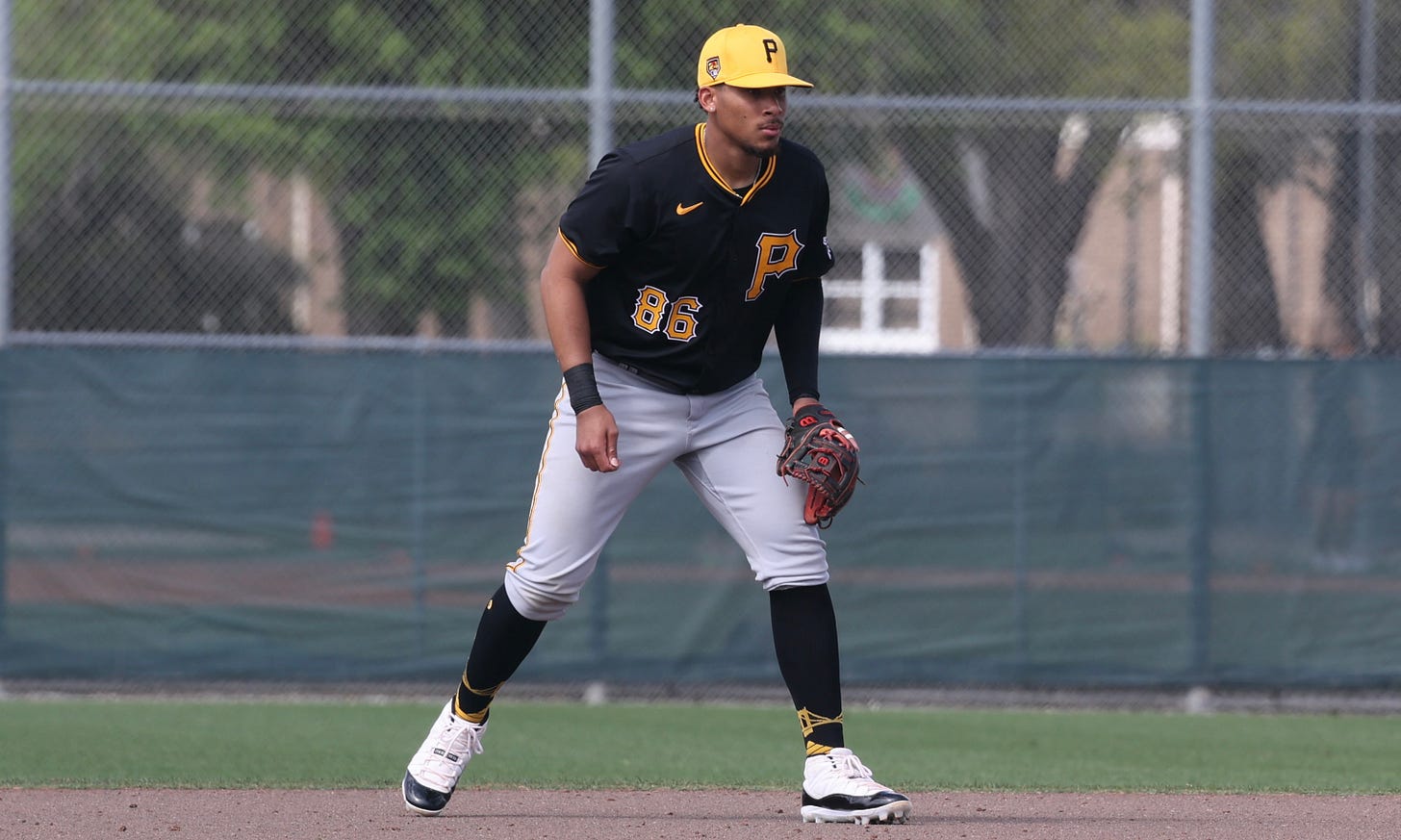Pirates' 2024 Minor League Recaps: Greensboro Part I, Hitters
All-or-nothing offense produces runs, whiffs
Greensboro had the best season of the Pirates’ full-season affiliates, going 75-55 and leading their division in the first half. That got the Grasshoppers a playoff spot, although they lost the opening series two games to one.
The Hoppers’ offense wasn’t exactly subtle. They easily led the 12-team South Atlantic League in home runs and runs, averaging nearly five and a half of the latter per game. The Greensboro ballpark no doubt helped with the long balls. When I give individual home run totals below, I’ll include the home/road splits in parentheses. They also piled up the strikeouts, finishing second in the league, far ahead of the third-place team. Greensboro kept winning — although not quite as often — despite a steady stream of promotions to Altoona.
The Prospects
Arguably, the Hoppers went into the season with four hitting prospects who had at least reasonably high ceilings. The results were mixed at best.
The marquee prospect on the team, of course, was Termarr Johnson. He struggled through the first two months of the season, batting .194 in April and .205 in May. He started coming around after that, putting up a .797 OPS in June and then .971 in July before slumping again in August. The Pirates promoted Johnson to Altoona in late August. On the season, he continued to draw walks at a prodigious rate; his total of 78 was second in the league. His K rate of 22% was reasonable by today’s standards and minuscule by Greensboro standards. He struggled badly with left-handed pitchers. Johnson hit 15 (9/6) home runs and had a slugging average (.385) that was a little above the league average and a little below the team average.
Johnson shared second base with Mitch Jebb and shortstop with Jebb and Jack Brannigan. Scouts seem to doubt whether he has the athleticism to stay at second, much less play short at higher levels. Johnson stole 20 bases in 24 tries with the Hoppers, which was encouraging. He didn’t turn 20 until mid-season, which made him two years younger than the league average for a hitter.
Brannigan’s season was disrupted by a late-July injury that cost him about six weeks; he played in only 77 of the team’s 130 games. He continued with patterns that have become common with the Pirates’ hitting prospects: a low average, a lot of strikeouts, and good or better power. In his limited time, Brannigan hit 18 long balls (10/8), good for fourth in the league despite the missed time. His final line was .231/.338/.475. His K rate was 27%, a hair above league average. He finished the season strongly, with an OPS of .961 in July (17 games) and .952 in September (6). In the field, he split his time between short, third, and second, in that order. Brannigan was a year older than average. As an early-round draftee from a major college, he needs to face AA competition before the stats mean much.
Jebb came into the season with a reputation as a fast, high-contact, high-average hitter, but he struggled to make contact in the early going. He fanned in 34% of his plate appearances in April. The contact issues gradually subsided, and he finished with a 19% K rate. He didn’t hit for average or power — the latter wasn’t surprising — and finished with a .251/.337/.352 line. The speed showed up in the form of 43 steals in 51 attempts. Jebb split his defensive time between second and short, more often the former. His infield defense didn’t impress observers a lot, and he had error problems in both positions. Some scouts thought he’d be best suited for center field, but he played only ten games there.
The remaining hitting prospect had the most difficulty of all. Lonnie White, Jr., managed to play 89 games despite some injuries, more than doubling his career total, but he struggled badly making contact. He had a 34% K rate, with a 10% walk rate. White hit 14 home runs (6/8) but finished with a slash line of .167/.275/.340. He spent the majority of his time in center, where, by all accounts, he’s an excellent defender.
Earning Promotions
Greensboro had several unheralded hitters put up big first-half numbers and get promoted to Altoona. This has to present challenges for the minor league staff, because the SAL is a moderate hitters league and Greensboro plays in a home run haven. It’s become common for Pirates’ hitting prospects to put up big numbers at Greensboro and hit a wall at Altoona.
The most prominent of these players with the Hoppers was Charles McAdoo. He was the team’s best hitter and got promoted after 60 games. Then he got traded, so his story for our purposes ends there.
A 2022 16th-rounder, Nick Cimillo, also put up big numbers for half a season. In 52 games, he hit .293/.419/.619, with 17 home runs (7/10) and a good BB:K ratio of 38:57. Drafted as a catcher, Cimillo has had to hit his way into playing time at every level and has settled in mainly as a DH and sometimes first baseman.
Sammy Siani, drafted in the supplemental first round way back in 2019, earned his promotion in just 20 games. He seemed to make a major adjustment to his approach and hit .324/.402/.563.
Whiffs and Wallops
On a team that piled up both home runs and strikeouts, there were bound to be some extremes, and the Hoppers didn’t disappoint. One such was White, but the most interesting was Shawn Ross. After signing him out of independent ball as an infielder, the Pirates moved Ross behind the plate. Despite the lack of experience, he seems to have handled catching well, throwing out 28% of base stealers and committing only seven passed balls. Ross also went all-in on a three-true-outcomes approach to hitting, enough so that he led the SAL with 23 home runs (12/11) while playing just 92 games. Ross struck out at a 35% rate and walked at a 15% rate. Despite hitting for a low average, he finished with a .193/.334/.459 slash line. Ross is nearly 25, so it’s critical to see whether he can sustain anything in AA.
The team’s most extreme strikeouts-and-homers guy was first baseman Josiah Sightler. He hit 14 home runs (8/6) in just 83 games but struck out in over half his at-bats and 45% of his plate appearances.
Late Additions
The Hoppers got some late-season reinforcements from Bradenton, the most notable of whom were catcher Omar Alfonzo, second baseman Duce Gourson, and shortstop Javier Rivas. Alfonzo continued a good season, in fact he hit better than he had for Bradenton. He put up a .247/.371/.457 line for the Hoppers, with five long balls (5/0) in 24 games. He caught only ten games but threw out 10 of 19 base stealers.
Gourson, this year’s 9th-round pick, got into 11 games after playing 11 with Bradenton. He struggled, going 7-for-39 with one double.
Rivas, not surprisingly, struggled with the bat, which isn’t his strong point. He went 4-for-32 with no walks and 14 strikeouts.
Struggling Prospects
The Hoppers had a couple of prospects from Ben Cherington’s initial, mostly failed trades who’ve struggled to advance. Outfielder Hudson Head, the top name at the time in the Joe Musgrove trade, returned to Greensboro for the third season. He hit just .208/.303/.383 (his OPS has declined each year), with 13 home runs (9/4) and a 32% strikeout rate. Infielder Maikol Escotto, the top return in the Jameson Taillon trade, had almost exactly the same year as he did at the same level last year: .215/.257/.355, with a 34% strikeout rate.
Organizational Players
Several other players picked up significant playing time. The most notable was outfielder P.J. Hilson. He arrived in the minor league phase of the Rule 5 draft and was promoted despite struggling early with Bradenton. Hilson took advantage of the Greensboro ballpark to hit 13 home runs (9/4) in 85 games. Hilson’s line was .257/.317/.443.
Other backups for most or all of the year were outfielder Luke Brown (.604 OPS), infielder Kalae Harrison (.480), and catcher Giovanny Planchart (.675). Planchart looked like a possible prospect at lower levels, but he didn’t do a lot offensively with the Hoppers beyond drawing a lot of walks, and he struggled defensively.
This site is 100% reader-supported, with no revenue coming from ads. If you enjoy our work, consider becoming a paid member today.
You will not only help the site grow but also get access to our fantastic premium content, which includes our Top 25 rankings and full-player write-ups, video breakdowns, and any features that come from my on-site trips.
Bucs On Deck is a reader-supported publication. To receive new posts and support my work, consider becoming a free or paid subscriber.









Thanks, WTM! This was an awesome read.
Man, that Taillon return was pretty brutal. I had high hopes for Ro early on and to a lesser degree, CSN. At least Musgrove netted Bednar, but the higher rated prospects in both trades did nothing.
if Termarr can’t play 2nd.. where can he play?